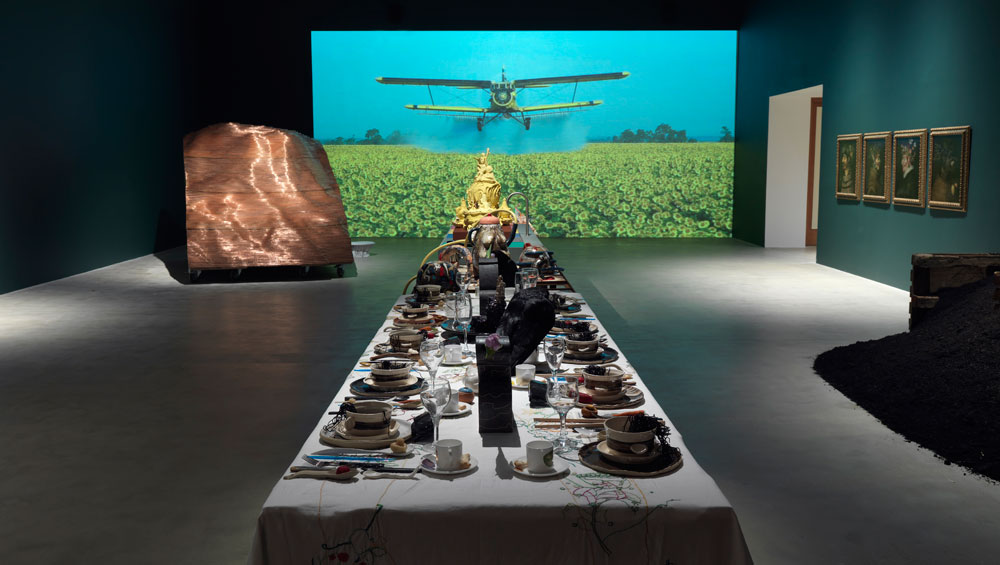
Hauser & Wirth Somerset, Bruton, Somerset
20 January – 7 May 2018
by VERONICA SIMPSON
For an exhibition looking to explore the “contradictory nature of society’s relationship to the rural”, there can be few better settings than Hauser & Wirth Somerset, a gallery comprising tastefully converted farm buildings, on a working farm, owned by the ultimate art-world It couple; conjuring that familiar narrative of urban sophisticates seeking respite from the pressures of city life in their pastoral idyll. And to accomplish this task, there can be few better curators than Adam Sutherland, the director of Grizedale Arts in Cumbria, whose mission is to disrupt the multiple stereotypes around the rural as picturesque backwater, and assert its right to be as vital a place for cultural production as anywhere else.
As guest curator, Sutherland appears to have been given free rein to bring in an extraordinary diversity of work, from medieval Korean ceramics to kitsch country music album covers, from cutting-edge conceptual art to Cumbrian Women’s Institute tea towels. There are 160 works and 50 international artists represented here, spanning the 1500s to the present day. It is an inclusive roster: from John Ruskin to Bedwyr Williams; Beatrix Potter to Karen Guthrie; William Holman Hunt to Carsten Höller.
Sutherland, who was born and raised on a farm, confesses: “[This survey show] almost encapsulates my own life history. I have a deep understanding of the rural.” He has done his time in the city - 15 years, including art school – before he agreed to reinvigorate the programme at Grizedale Arts, in Cumbria, joining in 1999. (Grizedale is a remarkable venture; a “curatorial project in a continuous state of development”, it is a working farm with a residency programme that positively discourages the creation of actual “art” in favour of finding a way in which art practice can become a useful, viable tool for enriching community identity.) Sutherland has spent decades meditating on the way the rural has been co-opted, celebrated, distorted, exploited and de-natured to suit the prevailing zeitgeist – as expounded in his thought-provoking 2009 book, Adding Complexity to Confusion. “Ultimately,” he says, “this exhibition has quite a lot of punctuation and puncturing preconceptions about the rural. In many ways it’s not really about the rural. It’s about nature and art.”
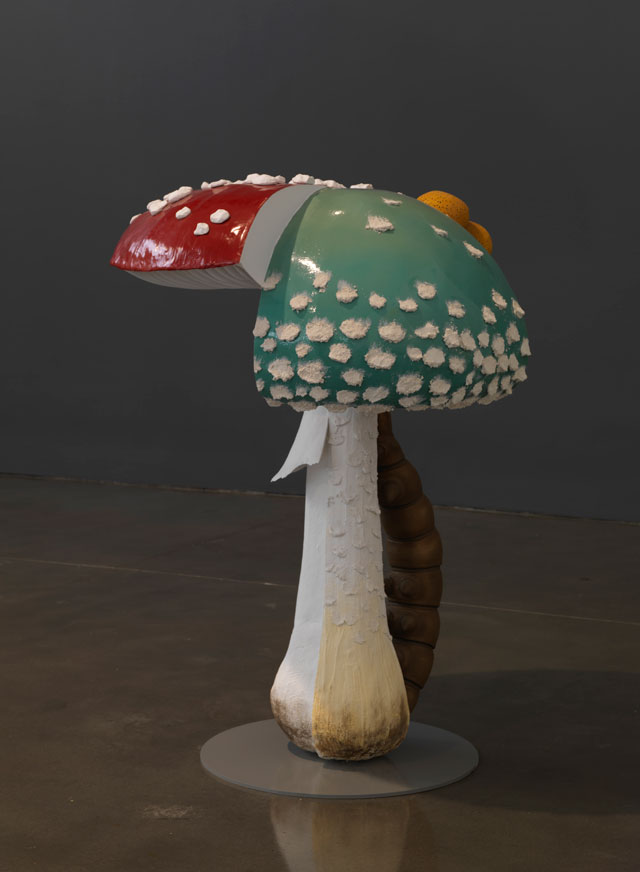
Carsten Höller. Giant Triple Mushroom, 2015. Photograph © Carsten Höller. Courtesy of Gagosian.
The first room offers a slow, sculptural introduction to a hugely complex topic. Flanking the doorway of this former threshing barn are two ceramic tree trunks, painted bright yellow (Foundation Myths, 2017, by Ordinary Architecture; there are more of these in the cloister).
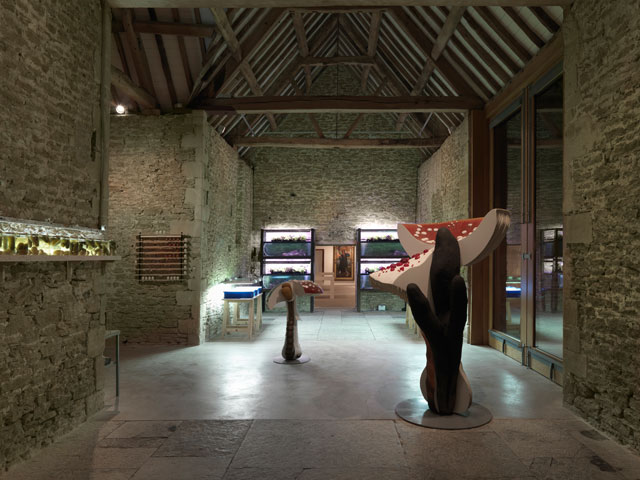
Threshing barn with mushrooms. Photograph: Veronica Simpson.
Tom Philipson offers us a shelf full of pickled eggs (Shelf, 2018), which is joined around the corner by another of his works, Egg Rack Calendar, 2018, featuring George Orwell’s egg record created while he wrote Animal Farm (a book that appears in a later vitrine). Two of Carsten Höller’s Giant Triple Mushrooms (2015) sprout from the polished concrete floor, the slender gills of the taller one supporting its gently domed cap with a grace not dissimilar to the ancient timbers overhead as they lift and hold the roof. Through a large window on the left, we see an elaborate wooden Goat Pavilion, (2017) designed by Fernando García-Dory together with Hayatsu Architects, which is occupied by real, live, somewhat irritable-sounding goats. Meanwhile, in the cloister, Hayatsu Architects has constructed a community bread oven.
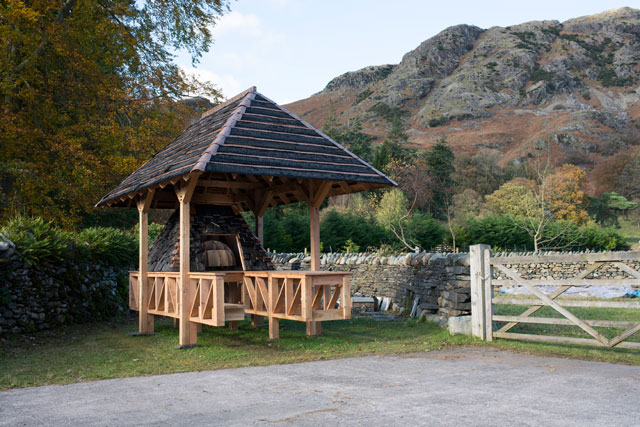
Hayatsu Architects and students from Central Saint Martins. Community Bread Oven, 2017. Image © Motoko Fujita 2017.
This room offers a sculptural, measured introduction – a mood of contemplation before the storm of content that follows – the multi-sensory impact of which is enhanced by a distinctive soundtrack: the gentle burbling of two fish tanks at the far end and the bleating of the goats. There are things being grown in trays under UV lamps: Eric Sjödin’s The Azolla Cooking and Cultivation Project, 2017, showing a bristling forest of azolla weed shoots. Says Sutherland: “Alice [Workman, director at H&W Somerset] was very keen to make something grow. In January, it’s a tricky time to do that.”
During the exhibition’s three-and-a-half-months’ duration, there will be demonstrations of all kinds, from cheese-making to goat-milking as well as several on aquaponics, a self-sustaining food production system where the waste produced by farmed fish supplies nutrients for plants that grow in the same water, while also purifying it for the fish. The aquaponic tanks in this show are supplied by the Sweet Water Foundation in Chicago. Sutherland says: “Sweet Water is from the south side of Chicago. It’s a war zone. There are two murders a day. The whole area has been flattened. Various people have tried to use the empty lots. Sweet Water has grown things randomly in these vacant lots and was so successful that it started a soup kitchen, which did so well that it led to them starting aquaponics workshops for education, which led to furniture workshops, which led to building houses - all in a relatively short space of time - and rebuilding communities.” In times of austerity, the earthy basics of food production have become a driver for change and growth, even in the most hostile of urban settings, says Sutherland, “although it has to look out for drive-by shootings when it is on its allotments … which we don’t tend to need in the Lake District.”
Sweet Water’s work reflects the utopian instincts that have led many urbanites to relocate to the countryside. The following room, the Workshop elaborates on this tradition.
This gallery and the converted Piggery that follows are laid out like an extraordinary, eccentric archive, the walls and showcases stuffed with marvellous things. Some items are arranged in sympathetic pairs – such as Williams’s Bard Attitude (2005), a photograph in which the artist adopts a cartoonish, bearded peasant pose in the Welsh wilderness, next to Grayson Perry’s empathic yet ironic Map of an Englishman (2004). In a horizontal glass case, a stiff and yellowing peasant smock is laid out alongside quaint folk embroidery, reverential illustrated Victorian tomes on native flora and fauna, William Nicholson’s somewhat patronising lithograph Y is for Yokel (1898), classic literature, postcards, even a flyer for Grizedale’s own Agrifashionista.TV intervention. Scattered around the showcases, like so many piquant paperweights, are Marcus Coates’s cast bronze goat droppings and other, more squirly mammal turds.

Showcase with Marcus Coates’s cast bronze goat droppings. Photograph: Veronica Simpson.
High art is juxtaposed gleefully with low. Along with Edward Calvert engravings, William Blake woodcuts, and Samuel Palmer etchings, there is a quartet of Christian country music album sleeves featuring radiant landscapes and glowing, radioactive-looking, produce – the good pilgrim’s association of abundance and fertility with divinity. There are plans for ornamental 18th-century garden, rustic and rusted farm tools, a Coniston Carving School Chair of 1901, which Sutherland says anyone could carve, with a modicum of training. The countryside as a place of honest and useful production is a recurring theme. Sutherland draws attention to a competent landscape in oils, painted around 1812. He points out that there are people in the landscape, reminding us how odd this might seem now: “The idea of a populated landscape is alien to us … You see it still in China. The first time I saw that - a whole landscape full of people – there was something really exciting about it, and you realise the landscape you normally see is dead and empty.”
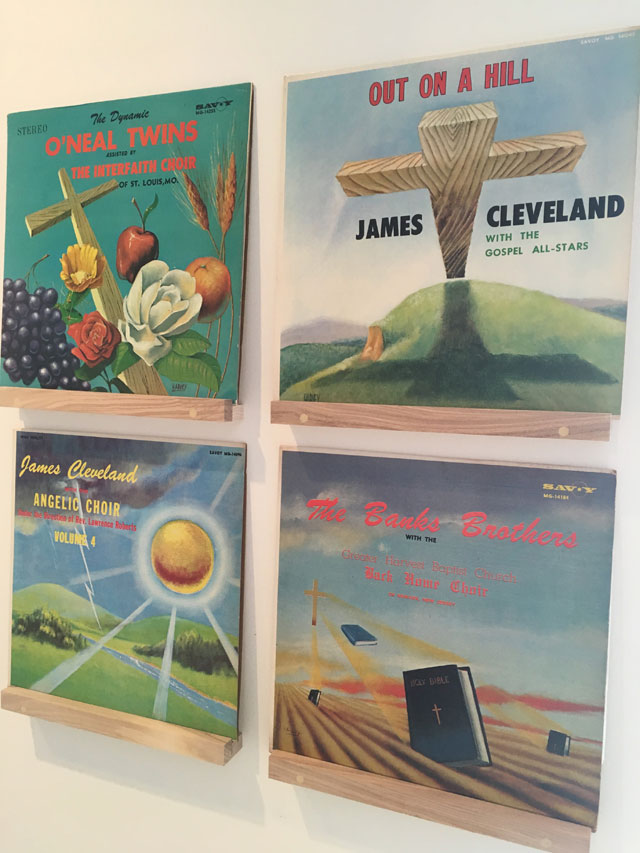
Christian country music album sleeves. Photograph: Veronica Simpson.
There are two disturbing photographic self-portraits by Stanislaw Ignacy Witkiewicz (also known as Witkacy) of around 1910. Like Ruskin, he set up a radical arts community, in Poland in the early 20th century, which pursued similar ideas of education through craft. Says Sutherland: “They set up a village school to make craft objects, assimilating the traditional styles and developing an architecture based on it. But they were doing it alongside the real rural thing, whereas in England they were acting out the arts and crafts ideals, and nobody actually knew how to use spinning wheels. Here (in Poland) that lifestyle was completely intact. So you had a bunch of arty intellectuals right alongside real hardcore highlander peasants, imitating them, wearing the same clothes, making their houses look the same. They were also wildly degenerate, in a way that the arts and crafts community weren’t.” This self-portrait is a good example, says Sutherland, taken from a slightly later period when Witkacy had begun to offer his customers a choice of four basic portrait styles, along with a say in the drugs under which the artist would be influenced - peyote, cocaine, marijuana. Either way, the results were disturbing. As Sutherland says: “People look like they’ve been fried.”
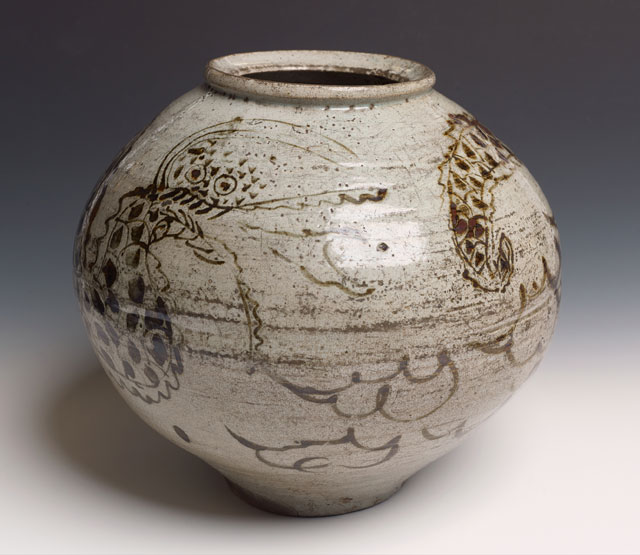
Unknown Artist. Dragon Jar, c1500–1600. Stoneware, glaze. © Manchester Art Gallery / Bridgeman Images.
There is so much to take in, and so many connections between the objects, but no obvious means of making them unless you are lucky enough to have Sutherland as genial guide at your elbow. He points to a large ceramic urn, the Dragon Jar (c1500-1600), and tells me: “This was made by a ‘Living National Treasure’ in Korea. In the 1960s in Korea and Japan, they created an asset register of National Intangible Cultural Assets. There are 127 of them. Many of them are very basic craft things such as roof tiles … there are dances, textile techniques, things of everyday life and everyday use. And then they created Living National Treasures to be the keepers of these skills, to keep these things going. They were normally people who were part of a living tradition, probably using the same kiln, probably the same family would go back several hundred years … And that pot there is an old piece of Joseon Dynasty (1392-1897). It’s 16th century. It’s a farm pot, to be used, and has been used for four or five hundred years.”
This particular pot came to Sutherland’s attention when a ceramicist –possibly one of these very same Living National Treasures – came to Grizedale. He cast a delicate, eau-de-nil dish that lies in a nearby showcase. And told them of this precious urn that had been hidden in the basement of the Manchester Museum for decades. This is the first time it has been exhibited in public. Sutherland also tells us that the National Treasure initiative, instead of preserving the traditional skills and artefacts of ancient Korea, has simply ended up making these Living National Treasures (and those who own their work) extremely rich; rustic artefacts - or rusticity itself – as branding exercise.
The room beyond (the Piggery) looks at the way in which nature and landscapes were appropriated between and after the two world wars. It draws on the work of the St Ives School, the influence of Dartington Hall and the Scouting movement. “There was a fantasy of the rural as a return to Eden, in opposition to industrialisation,” Sutherland says. He has had some fun with placement here: Bambi (150 years of Disney Commission, 2015), a sugary confection by Thomas Kinkade - arguably one of the US’s most successful commercial landscape painters - is placed above a small oil painting by Kurt Schwitters of an apple store in the Cumbrian town of Ambleside, along with a Lilliput Lane model of an almost identical apple store: your very own piece of a ceramic rural fantasy village wreathed in nostalgia; buyers even get the “deeds” to their own Lilliput Lane properties.
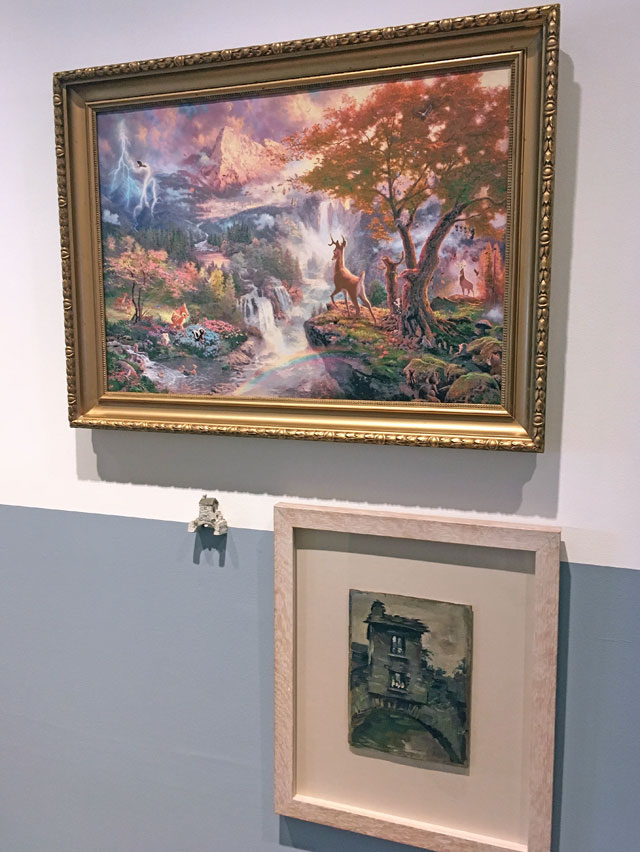
Thomas Kinkade. Bambi, 2015 (top); Kurt Schwitters painting of an apple store (below); Lilliput Lane model of an apple store. Photograph: Veronica Simpson.
The fourth room is very much darker, more visceral. Deep-green walls form an atmospheric backdrop for Anchorhold (2015), a collaborative temple to the apple by Coates and Sutherland Hussey Architects, along one wall. Opposite, a spotlight shines on a radiant, idealised landscape: John Martin’s Sadak in Search of the Waters of Oblivion (1812) – surely a template for the Lord of the Rings scenographers. Further on, there is the undulating copper roof of House of Ferment (2016) by artist Karen Guthrie and Front Designs. Created as a Grizedale Arts project, it celebrates the urge to preserve and ferment foods, acting as a living archive both of Guthrie’s food habits and the communities she engages with it.
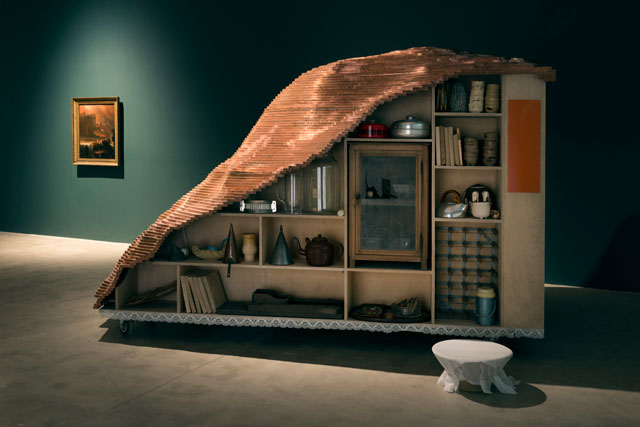
Karen Guthrie and Front Designs. House of Ferment, 2016. Courtesy of Hauser & Wirth. Photograph: Ken Adlard.
Down the middle of the room are two baroque feasting tables that turn out, on closer inspection, to be something far more sinister and disturbing - stuffed crows, jewellery as food, lactating ceramic urns, cutlery made from scorched twigs and vegetables – it is an amalgamation of many artists’ work, including that of Ryan Gander, Rob Kesseler, Laure Prouvost, Williams and Aaron Angell. At the end of the room is a screen showing the kind of entertainment that would put most people off their dinners: Nikolaus Geyrhalter’s Our Daily Bread (2005) shows the horrors of industrial farming. Pigs are injected, dissected, dispassionately disembowelled by calm workers in plastic aprons and hairnets.
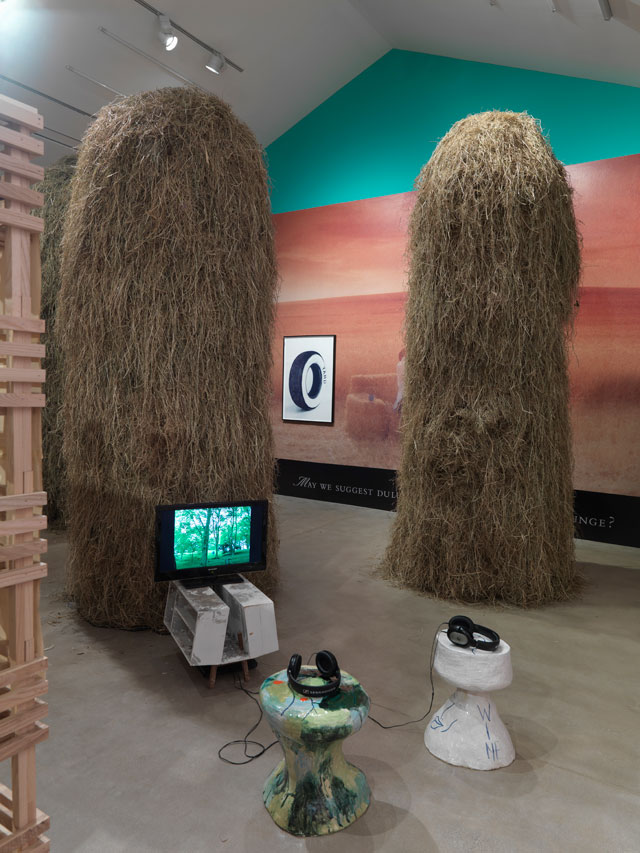
Simon Fairlie. Haystacks, 2018. Photograph: Veronica Simpson.
It is something of a relief to enter the large salon space that follows in the Bourgeois Gallery, its bookshelves, tables and cushions punctuated by Simon Fairlie’s huge Haystacks (2018), and the surreal interventions of Olaf Breuning’s I am Scared of Nature (2009) and Paul McCarthy’s The Bavarian Deer (1987/99). It is an odd but welcoming place for discussion, interrogation and debate, which the gallery’s impressive education and outreach programme will no doubt make full use of.
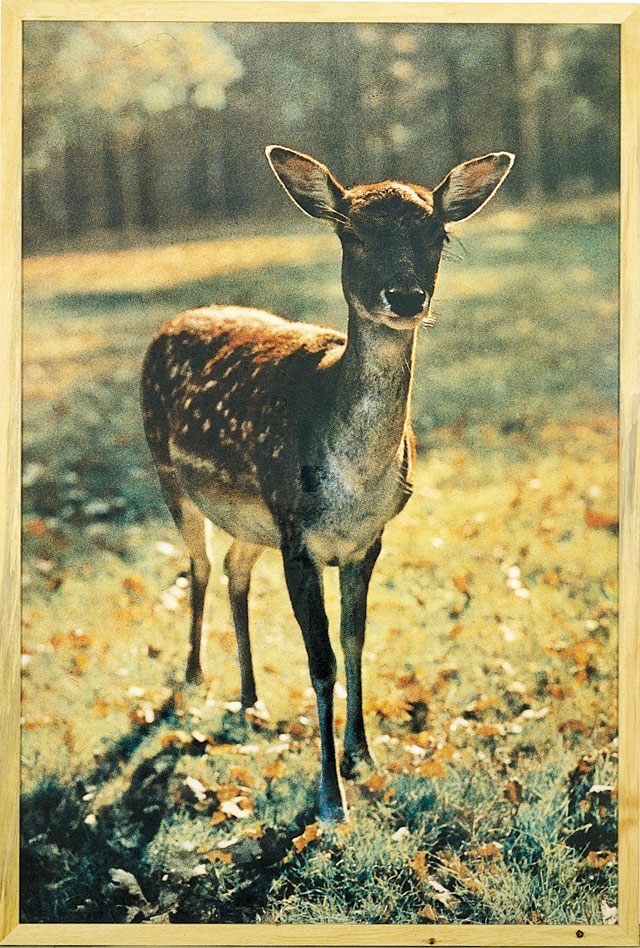
Paul McCarthy. The Bavarian Deer, 1987/1999. © Paul McCarthy. Courtesy of the artist and Hauser & Wirth.
At the opening, I happen across Mark Wallinger voicing (to camera, for the gallery’s promotional footage) the origins of his work Stately Home (1985), which hangs in the lobby beyond the Rhoades Gallery. “It was based on an engraving my father found,” he says (of Hare Hall in Essex - a Palladian mansion, built to designs by James Paine, in 1769-70, for John Arnold Wallinger). “It hung in our hallway, part of a joke about our blue-blooded connections, of which there are none. And then I subtly altered it by introducing a T rex, which appears to be in some conflict with a hunter.” The piece was in Wallinger’s degree show in 1985, part of a work called National Trust, which, he says, “kind of engaged with how the English countryside has changed to be consumed as part of the heritage industry”. Most appropriately – or ironically – his work is accompanied by a very fetching and colourful “honesty shop”, where local artists and makers are selling their wares, with an honesty box for payment.
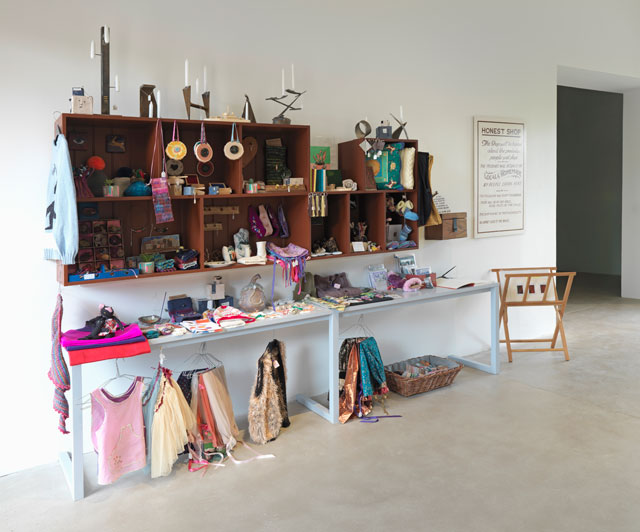
The honesty shop. Photograph: Veronica Simpson.
Wallinger also reveals that the title of the show is taken from a toast, presumably dating back to one of the UK’s many waves of migration. Leading the toast, a departing Brit would raise a glass to “The Land we Live in”, to which the rest of the crew/voyagers would reply “The land we left behind”, as they sailed off into the distance.
There is complexity and confusion aplenty in this show – the perfect compost, in fact, for conversation. And, apparently, the gallery staff are being trained to recount some of Sutherland’s rich anecdotal repertoire to help engage with visitors – adding, in person, what captions fail miserably to do in print. Whether it fertilises ambitions and empowers the community around this gallery’s setting to see their location differently - as a place as vital as any city to the production of art – we can only wait and see.